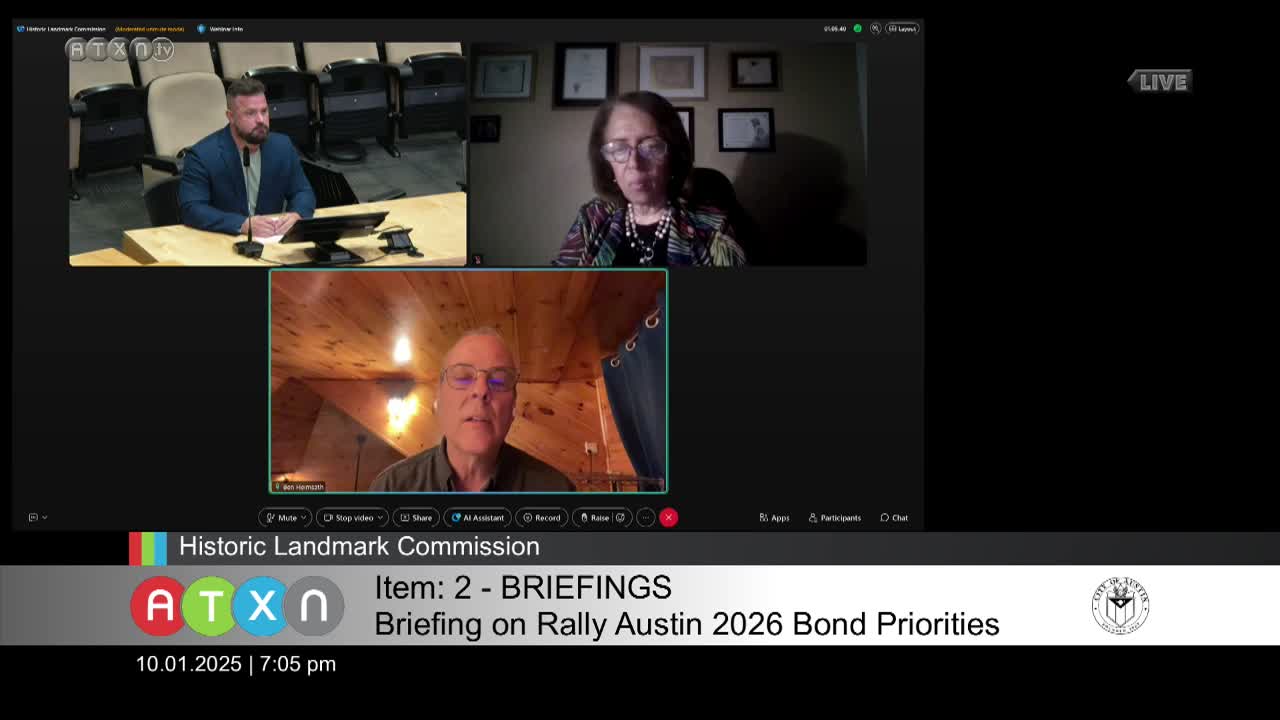TxDOT briefs commission on I‑35 interpretive framework to guide community storytelling along corridor
October 01, 2025 | Austin, Travis County, Texas
This article was created by AI summarizing key points discussed. AI makes mistakes, so for full details and context, please refer to the video of the full meeting. Please report any errors so we can fix them. Report an error »

The Texas Department of Transportation (TxDOT) briefed the Historic Landmark Commission Oct. 1 on development of an interpretive framework for the I‑35 corridor in Austin.
Rebecca DeBrasco, TxDOT’s cultural resources section director, described the project as a mitigation and coordination tool that will compile themes, audience guidance and shared resources for organizations developing interpretive storytelling and public history projects along I‑35 from downtown Austin north toward Airport Boulevard. DeBrasco said TxDOT funded the planning document but intentionally designed it as a stakeholder‑led framework rather than a prescriptive, TxDOT‑owned narrative; the framework is intended to support community organizations, museums, nonprofits and public art efforts.
TxDOT convened a working group of roughly 35–50 participants representing government departments, universities, preservation groups and community organizations. The agency is in phase 2 of the project: consultants are doing research and staff will work with the working group in additional sessions before finalizing the framework in 2026. DeBrasco said the plan could be useful for shared interpretive themes, audience targeting and coordination among organizations. The plan, she said, will not itself include funding for installation or material projects; organizations seeking physical interpretive projects would pursue funding separately.
Commissioners asked about coordination with local funding and signage, and expressed concern that a planning framework without tied funding could result in uneven outcomes across communities. Commission members urged TxDOT to ensure the working group includes grassroots and under‑resourced organizations so stories from all communities along the corridor have a voice. TxDOT staff and city staff said they would make the working‑group participant list available to the commission upon request and offered to return with the finalized framework when complete.
The briefing concluded with staff and commissioners encouraging continued collaboration between TxDOT, the city and local organizations to ensure the interpretive framework informs equitable, well‑funded projects rather than remaining only a planning exercise.
Rebecca DeBrasco, TxDOT’s cultural resources section director, described the project as a mitigation and coordination tool that will compile themes, audience guidance and shared resources for organizations developing interpretive storytelling and public history projects along I‑35 from downtown Austin north toward Airport Boulevard. DeBrasco said TxDOT funded the planning document but intentionally designed it as a stakeholder‑led framework rather than a prescriptive, TxDOT‑owned narrative; the framework is intended to support community organizations, museums, nonprofits and public art efforts.
TxDOT convened a working group of roughly 35–50 participants representing government departments, universities, preservation groups and community organizations. The agency is in phase 2 of the project: consultants are doing research and staff will work with the working group in additional sessions before finalizing the framework in 2026. DeBrasco said the plan could be useful for shared interpretive themes, audience targeting and coordination among organizations. The plan, she said, will not itself include funding for installation or material projects; organizations seeking physical interpretive projects would pursue funding separately.
Commissioners asked about coordination with local funding and signage, and expressed concern that a planning framework without tied funding could result in uneven outcomes across communities. Commission members urged TxDOT to ensure the working group includes grassroots and under‑resourced organizations so stories from all communities along the corridor have a voice. TxDOT staff and city staff said they would make the working‑group participant list available to the commission upon request and offered to return with the finalized framework when complete.
The briefing concluded with staff and commissioners encouraging continued collaboration between TxDOT, the city and local organizations to ensure the interpretive framework informs equitable, well‑funded projects rather than remaining only a planning exercise.
View full meeting
This article is based on a recent meeting—watch the full video and explore the complete transcript for deeper insights into the discussion.
View full meeting
